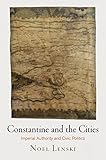Constantine and the Cities : Imperial Authority and Civic Politics / Noel Lenski.
Material type: TextSeries: Empire and AfterPublisher: Philadelphia : University of Pennsylvania Press, [2016]Copyright date: ©2016Description: 1 online resource (416 p.) : 56 illusContent type:
TextSeries: Empire and AfterPublisher: Philadelphia : University of Pennsylvania Press, [2016]Copyright date: ©2016Description: 1 online resource (416 p.) : 56 illusContent type: - 9780812247770
- 9780812292237
- 937/.08 23
- online - DeGruyter
- Issued also in print.
| Item type | Current library | Call number | URL | Status | Notes | Barcode | |
|---|---|---|---|---|---|---|---|
 eBook
eBook
|
Biblioteca "Angelicum" Pont. Univ. S.Tommaso d'Aquino Nuvola online | online - DeGruyter (Browse shelf(Opens below)) | Online access | Not for loan (Accesso limitato) | Accesso per gli utenti autorizzati / Access for authorized users | (dgr)9780812292237 |
Frontmatter -- Contents -- List of Maps -- Introduction. Many Faces of Constantine -- Part I. Constantine's Self-Presentation -- Chapter 1. Constantine Develops -- Chapter 2. Constantinian Constants -- Chapter 3. Constantine and the Christians -- Part II. The Power of Petitions -- Chapter 4. Approaching Constantine -- Chapter 5. The Exigencies of Dialogue -- Chapter 6. Constantine's Cities in the West -- Chapter 7. Constantine's Cities in the East -- Part III. Reconstructing the Ancient City -- Chapter 8. Redistributing Wealth -- Chapter 9. Building Churches -- Chapter 10. Empowering Bishops -- Part IV. Alternative Responses to Constantine -- Chapter 11. Engaging Cities -- Chapter 12. Resisting Cities -- Chapter 13. Opposing Christians -- Chapter 14. Complex Cities -- Epilogue -- Sigla and Abbreviations -- Notes -- Bibliography -- Index -- Acknowledgments
restricted access online access with authorization star
http://purl.org/coar/access_right/c_16ec
Over the course of the fourth century, Christianity rose from a religion actively persecuted by the authority of the Roman empire to become the religion of state-a feat largely credited to Constantine the Great. Constantine succeeded in propelling this minority religion to imperial status using the traditional tools of governance, yet his proclamation of his new religious orientation was by no means unambiguous. His coins and inscriptions, public monuments, and pronouncements sent unmistakable signals to his non-Christian subjects that he was willing not only to accept their beliefs about the nature of the divine but also to incorporate traditional forms of religious expression into his own self-presentation. In Constantine and the Cities, Noel Lenski attempts to reconcile these apparent contradictions by examining the dialogic nature of Constantine's power and how his rule was built in the space between his ambitions for the empire and his subjects' efforts to further their own understandings of religious truth.Focusing on cities and the texts and images produced by their citizens for and about the emperor, Constantine and the Cities uncovers the interplay of signals between ruler and subject, mapping out the terrain within which Constantine nudged his subjects in the direction of conversion. Reading inscriptions, coins, legal texts, letters, orations, and histories, Lenski demonstrates how Constantine and his subjects used the instruments of government in a struggle for authority over the religion of the empire.
Issued also in print.
Mode of access: Internet via World Wide Web.
In English.
Description based on online resource; title from PDF title page (publisher's Web site, viewed 30. Aug 2021)


